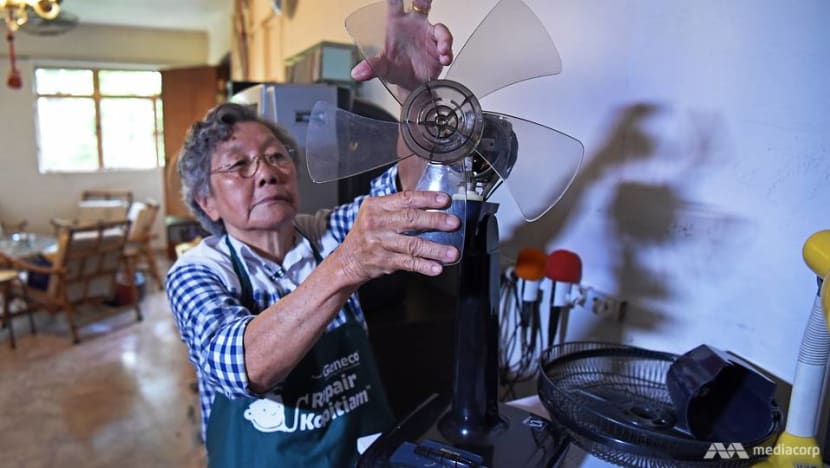If you don’t try to fix it you’ll never know: A 79-year-old retiree who's the neighbourhood handyman

Ms Tang Sai Tham often gets requests to repair small household appliances such as fans and radios. (Photo: Hanidah Amin)
SINGAPORE: Her hands were shaking slightly as Ms Tang Sai Tham used a screwdriver to open the safety grill of a table fan. She pulls out the fan blades to show us the motor inside.
"Many people think fans are broken because the blades are moving slowly so there's no wind. But usually the moving parts inside are just rusty or dirty, so the blades move slowly.
"I think this might be rusty. You just have to take the fan apart and clean the insides, and it should work," she added as she fitted the blades back on, and checked if they were running smoothly.
Hand tremors and old age (she's 79) have not stopped Ms Tang from pursuing her interest in repair work. When she is not spending time at the nearby community centre or bowling with her friends, she often finds appliances to take home and repair, either from people who no longer want them, or at the void deck of HDB blocks.
Many Singaporeans throw away appliances, especially fans and radios, that are still in working condition, Ms Tang observed.
“When I see things being thrown away, I think about why it is broken. Just like when you’re sick, you have to go to the doctor and figure out why you’re sick, and ask the doctor if he can help you get well,” she told CNA in Mandarin.
Despite not having any formal technical education or training, Ms Tang has done this for about 40 years, learning how to fix furniture like cupboards and tables, and appliances like rice cookers, radios and more.
AN ANALOGUE LOVER
Entering Ms Tang’s home in Ang Mo Kio is like traveling back in time to the analogue age, with appliances and furniture from yesteryears lining the corridors and walls. Visitors are greeted with well-maintained, vintage furniture and drawers and cupboards full of vinyl records, video tapes and cassettes.
One of the oldest objects in her home is a Philips vinyl record player that she bought when she was in her 20s, about 50 years ago. She saved up almost a year for it. Unfortunately, it no longer works because the needle is broken and Ms Tang has yet to find the right spare part.
“If I had the needle, this thing would still work.” she said, adding that she is still searching for the right needle, and will not hesitate to pay for it if she finds it. “Money is not an issue.”
Another one of her prized possessions is a karaoke set that she built herself by combining a boxy cathode ray television, several DVD players, two amplifiers and two microphones.
Showing off her extensive collection of karaoke DVDs, Ms Tang explained that many of the components of the karaoke set were given to her by neighbours or friends who had replaced their speakers and DVD players.
“The TV was so heavy, I had to ask a few people to help me carry it home before I could fix it. It works now, but only for playing from the CD players, it has no signal and you can’t watch TV on it,” she explained.
BUY AND THROW AWAY
Ms Tang strongly believes that more people should try to repair their appliances or furniture before throwing them away, as this is less wasteful and better for the environment.
“If you try to fix it, then you will know whether you can save the item. If you don’t try to fix it you’ll never know,” she added.

To learn how to repair the items she finds, she usually goes to second-hand shops or other neighbourhood repair shops to ask for advice.
“I will go to the shop after finding out where the item is from. I won’t bring the item there. If I bring it there they won’t teach me.
“I’ll tell them the situation, and they would tell me: ‘Maybe you can try changing this wire to that side and see what happens.’”
Ms Tang said that after some trial and error, she usually figures out what the problem is and how to fix it.
Ms Tang's ability to repair items is known to her neighbours in Ang Mo Kio, where she has lived for more than 30 years. They often ask her for help to fix household appliances and furniture. They also give her their old appliances when they buy new ones, because they know she enjoys tinkering with them.
“There was once a lady who asked me to help her fix her washing machine. I said I don’t know how to fix it and I can’t fix it. It’s so big, it’s not like a small radio you can carry around,” Ms Tang shared.
After fixing the appliances, Ms Tang either uses them at home, or gives them away to neighbours who need them. Most of the time, people ask her if she has fans or radios to spare.
NEIGHBOURLY BONDS
She has also become close friends with her neighbours who look out for her. Ms Tang shared that last year, her gall bladder ruptured when she was at home. She was in a lot of pain, and could not move, said Ms Tang.
Her immediate neighbour noticed that he had not seen her the whole day, and went to check on her. When he looked into her unit, he saw her sitting on a chair, in obvious pain.
He insisted on calling an ambulance to take her to the hospital. She ended up being hospitalised for a few days.
“At first I didn’t want to go to the hospital because I thought the pain would pass. When I got there, the doctor told me it was lucky that my neighbour found me. It could’ve been serious,” added Ms Tang.
“She doesn’t take payment for helping us with repairs and that kind of stuff, so when I have extra food I will share it with her,” said her neighbour Mdm Toh Eng Hng, whose son called the ambulance.
Acknowledging that her friends and neighbours often worry because she is independent and prefers to solve problems by herself, Ms Tang explained that she does not want to call a repairman for help unless she needs it.
For example, when the door of one of her cupboards fell off, she climbed on two chairs to screw it back in because she is not tall enough to reach the top shelf.
Ms Tang explained: “I didn’t think I had to call a repairman over a small thing. You should only ask for help if you can’t do it yourself.”
Knowing that she loves to repair things, a friend introduced Mr Tang to Repair Kopitiam earlier this year, an initiative that aims to reduce the impact of Singapore's throw away culture.
As the oldest certified “coach” of Repair Kopitiam, Ms Tang enjoys attending the monthly community repair sessions.
“There are more things to see there, it’s not just fixing things. There are so many types of appliances that I usually can’t get.”
Even though Ms Tang has tried taking apart computers, she does not know how to fix them and is still learning about the different components in a computer. She has a laptop and a desktop computer at home that she uses to play games and archive photos from her phone, as well as a CPU waiting to be taken apart and explored.
When asked about her collection at home, and why she has multiples of the same item, Ms Tang explained that she does not like throwing away things that are not broken. “I have so many things at home, I keep them because no one wants them.”
“I like collecting old things, so I never throw things away,” she said.
“You can’t find these anywhere now.”














